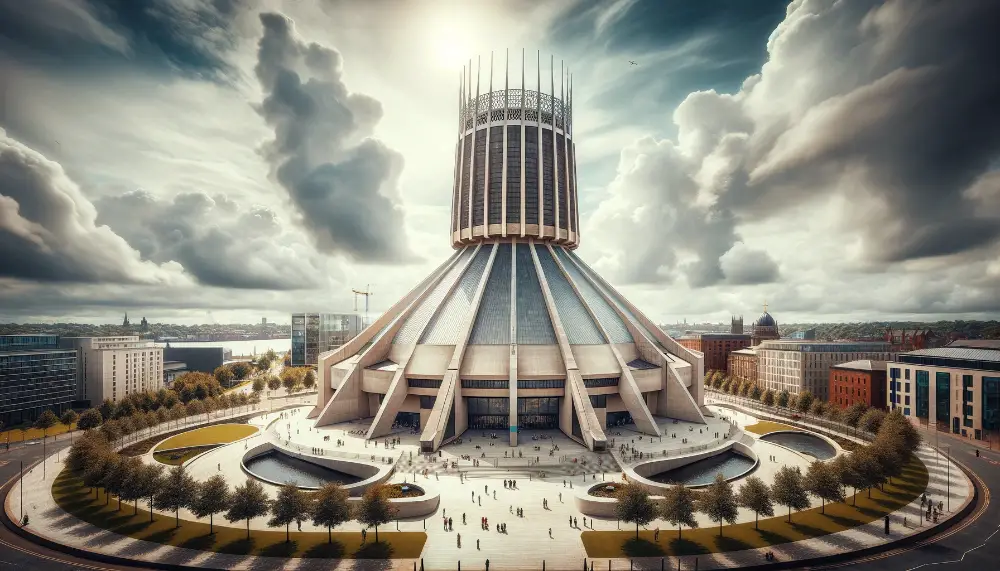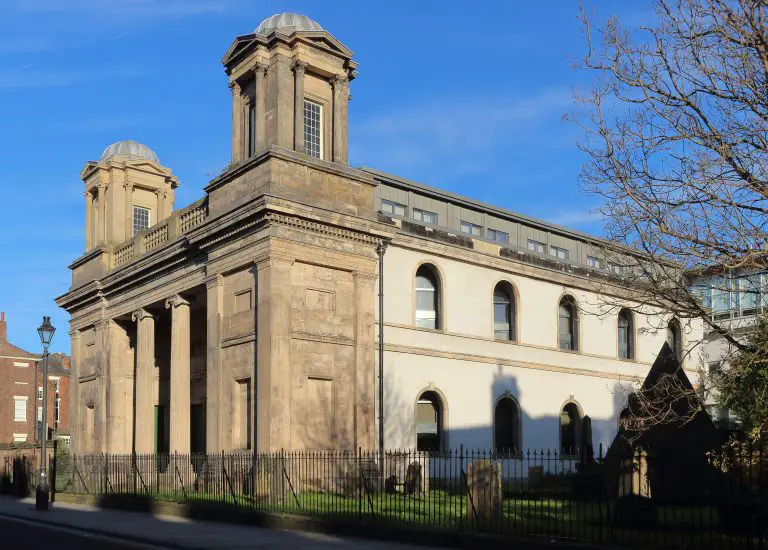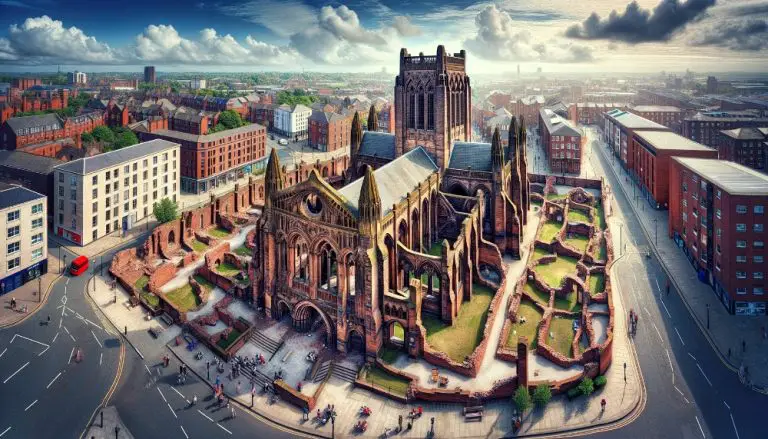Liverpool Metropolitan Cathedral

The Liverpool Metropolitan Cathedral is also known as the Metropolitan Cathedral of Christ the King. As the seat of the Archbishop of Liverpool and the mother church of the Roman Catholic Archdiocese of Liverpool, this stunning cathedral holds a significant place in the heart of the city. Designed by Sir Frederick Gibberd and completed in 1967, it is not only a symbol of faith but also a cherished tourist attraction and an architectural gem. Join me as we explore the beauty and history of the Liverpool Metropolitan Cathedral, an iconic landmark of Liverpool.
Key Takeaways:
- The Liverpool Metropolitan Cathedral, also known as the Metropolitan Cathedral of Christ the King, is a prominent landmark and tourist attraction in Liverpool.
- Designed by Sir Frederick Gibberd and completed in 1967, the cathedral features a unique and striking architectural design.
- Visitors can embark on guided tours, attend music concerts, explore the Lutyens Crypt, and enjoy interactive family trails.
- The cathedral’s location in the heart of Liverpool makes it easily accessible for sightseeing.
- A visit to the Liverpool Metropolitan Cathedral offers a peaceful and reflective atmosphere, along with breathtaking stained glass windows.
History of the Liverpool Metropolitan Cathedral
The Liverpool Metropolitan Cathedral has a rich history that spans over a century. Its story begins in the mid-19th century when the Catholic population in Liverpool experienced a significant increase due to the Great Irish Famine. Recognizing the need for a grand cathedral to serve the growing faith community, Bishop Alexander Goss embarked on a mission to bring this vision to life.
After careful consideration, the grounds of St. Edward’s College were chosen as the location for the cathedral. This selection was made with the intention of creating a place of worship that would be visible from various points in Liverpool, serving as a symbol of the Catholic faith and its importance in the city.
Throughout the years, several renowned architects contributed their designs to the cathedral. Notably, Edward Welby Pugin and Sir Edwin Lutyens presented their visionary concepts. However, it wasn’t until 1962 that construction began under the esteemed architect Sir Frederick Gibberd.
Despite facing challenges and architectural flaws, the Liverpool Metropolitan Cathedral was completed in 1967. It stands today as a testament to faith, innovation, and the determination of those who brought this magnificent structure to fruition.
| Designers | Years |
|---|---|
| Edward Welby Pugin | 1853-1862 |
| Sir Edwin Lutyens | 1920-1930 |
| Sir Frederick Gibberd | 1962-1967 |
Architecture of the Liverpool Metropolitan Cathedral
The Liverpool Metropolitan Cathedral is renowned for its striking and modern architecture. With a circular design and a diameter of 195 feet, the cathedral boasts a unique conical shape that sets it apart from traditional cathedral structures. Constructed using concrete and adorned with a Portland stone cladding, it showcases a distinctive aluminium roof, adding to its contemporary appeal.
One of the outstanding features of the Liverpool Metropolitan Cathedral is its breathtaking stained glass windows. Designed by renowned artists John Piper and Patrick Reyntiens, these windows illuminate the interior with vibrant colors and intricate patterns, creating a mesmerizing visual experience for visitors. The play of light and color adds depth and beauty to the cathedral, further enhancing its architectural magnificence.
| Key Features | Description |
|---|---|
| Circular Design | The cathedral’s circular design, with a diameter of 195 feet, showcases a unique conical shape that sets it apart. |
| Stained Glass Windows | Designed by John Piper and Patrick Reyntiens, the cathedral’s stained glass windows illuminate the interior with vibrant colors and intricate patterns. |
| Lutyens Crypt | The cathedral features the Lutyens Crypt, a unique underground space that was part of the original design by Sir Edwin Lutyens. |
Another notable highlight of the Liverpool Metropolitan Cathedral is the Lutyens Crypt. Originally conceptualized by Sir Edwin Lutyens, this underground space within the cathedral complex offers a one-of-a-kind experience for visitors. Its design and purpose add depth and character to the cathedral, showcasing the vision and creativity of its architects.
Highlights of a Visit to the Liverpool Metropolitan Cathedral
A visit to the Liverpool Metropolitan Cathedral offers a range of highlights and experiences for visitors of all ages. Whether you’re interested in history, architecture, music, or interactive activities, there’s something for everyone to enjoy at this iconic cathedral.
Location
The Liverpool Metropolitan Cathedral is situated on Mount Pleasant in the city of Liverpool, England. Its precise geographical coordinates are 53°24’17″N 2°58’08″W. The central location of the cathedral allows for easy accessibility and makes it a convenient stop for sightseeing in Liverpool.
Nearby Attractions and Points of Interest
The Liverpool Metropolitan Cathedral is located in a vibrant area of Liverpool, with several other attractions and points of interest nearby. One of the most notable landmarks is the Liverpool Cathedral, the Anglican counterpart to the Metropolitan Cathedral, located a 15-minute walk away on Hope Street. This area is known for its architectural wonders and is a popular destination for sightseeing in Liverpool.
| Attraction | Distance from Metropolitan Cathedral |
|---|---|
| Liverpool Cathedral | 15-minute walk |
| Everyman Theatre | 5-minute walk |
| Philharmonic Dining Rooms | 10-minute walk |
| Walker Art Gallery | 20-minute walk |
How to Get to the Liverpool Metropolitan Cathedral
The Liverpool Metropolitan Cathedral is conveniently located and easily accessible by various modes of transportation. Whether you prefer public transportation or driving, there are options available to suit your needs.
Public Transportation
If you plan to use public transportation, you’ll be pleased to know that several bus stops and train stations are within walking distance of the cathedral. This makes it convenient for visitors to reach their destination without hassle. Simply check the local bus and train schedules to find the most suitable option for your journey.
Conclusion
The Liverpool Metropolitan Cathedral is a breathtaking architectural masterpiece and a true testament to faith in Liverpool. Its unique design, characterized by its circular shape and conical roof, sets it apart from other cathedrals around the world. The stunning stained glass windows, designed by John Piper and Patrick Reyntiens, create a vibrant display of colors and patterns that captivate visitors.
Stepping inside the cathedral, one immediately feels a sense of peace and tranquility. The serene atmosphere offers a welcome respite from the bustling city outside. Whether you’re exploring the cathedral’s rich history, attending a music concert, or simply taking in the beauty of the surrounding area, a visit to the Liverpool Metropolitan Cathedral is a truly memorable and enriching experience.
Located in the heart of Liverpool, the cathedral is easily accessible and surrounded by other notable attractions. From the nearby Liverpool Cathedral to the vibrant Hope Street, there is so much to explore in the vicinity.
FAQ
What is the official name of the Liverpool Metropolitan Cathedral?
The official name of the Liverpool Metropolitan Cathedral is the Metropolitan Cathedral of Christ the King.
Who is the Archbishop of Liverpool?
The Archbishop of Liverpool is the head of the Roman Catholic Archdiocese of Liverpool and holds the seat in the Liverpool Metropolitan Cathedral.
When was the Liverpool Metropolitan Cathedral completed?
The Liverpool Metropolitan Cathedral was completed in 1967.
What is the nickname of the Liverpool Metropolitan Cathedral?
The Liverpool Metropolitan Cathedral is popularly known as “Paddy’s Wigwam” due to its unique design.
Who designed the Liverpool Metropolitan Cathedral?
The Liverpool Metropolitan Cathedral was designed by Sir Frederick Gibberd.
What is the architectural style of the Liverpool Metropolitan Cathedral?
The Liverpool Metropolitan Cathedral features a circular design with a conical shape and is made of concrete with a Portland stone cladding.
What are the highlights of a visit to the Liverpool Metropolitan Cathedral?
Visitors to the Liverpool Metropolitan Cathedral can enjoy guided tours, music concerts, explore the Lutyens Crypt, and take audio tours in multiple languages. Families can also enjoy an interactive family trail.
Where is the Liverpool Metropolitan Cathedral located?
The Liverpool Metropolitan Cathedral is located on Mount Pleasant in Liverpool, England.
What are the opening hours of the Liverpool Metropolitan Cathedral?
The Liverpool Metropolitan Cathedral is open daily from 7:30 AM to 6:00 PM.
What do visitors praise about the Liverpool Metropolitan Cathedral?
Visitors appreciate the stunning architecture, beautiful stained glass windows, and the peaceful atmosphere of the Liverpool Metropolitan Cathedral.
What other attractions are near the Liverpool Metropolitan Cathedral?
The Liverpool Cathedral, the Anglican counterpart to the Metropolitan Cathedral, is located a 15-minute walk away on Hope Street.
What accommodation options are available near the Liverpool Metropolitan Cathedral?
There are several hotels and guesthouses located within walking distance of the Liverpool Metropolitan Cathedral.
How can I get to the Liverpool Metropolitan Cathedral?
The Liverpool Metropolitan Cathedral is easily accessible by public transportation, with bus stops and train stations within walking distance. There are also multiple car parks available for visitors driving to the cathedral.
Source Links
- https://en.wikipedia.org/wiki/Liverpool_Metropolitan_Cathedral
- https://liverpoolmetrocathedral.org.uk/visit-us/
- https://www.tripadvisor.co.uk/Attraction_Review-g186337-d213954-Reviews-Metropolitan_Cathedral_of_Christ_the_King_Liverpool-Liverpool_Merseyside_England.html
- The History Behind Liverpool’s You’ll Never Walk Along - February 16, 2024
- The History of Everton FC - February 16, 2024
- The History of Liverpool FC - February 16, 2024



